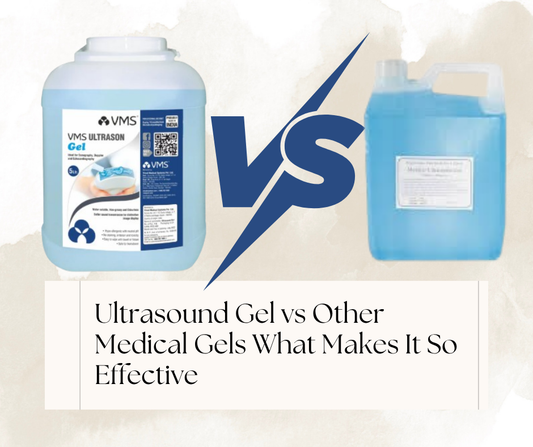In the world of medical imaging and diagnostics, precision is everything. From capturing the heartbeat of an unborn baby to identifying internal abnormalities, clear imaging is what allows doctors to make accurate diagnoses. Yet, behind every crystal-clear ultrasound or ECG reading lies a simple but powerful product the ultrasound gel.
While it might look like an ordinary, transparent liquid, the ultrasound gel is an essential medium that ensures sound waves travel efficiently between the transducer and the patient’s body. But what makes ultrasound gel so unique compared to other medical gels like ECG gel, sonography gel, or ultrasonic gel? Let’s dive deeper into what sets it apart and why it plays such a vital role in modern healthcare.
Understanding the Basics What Exactly Is an Ultrasound Gel?
An ultrasound gel is a specially formulated conductive medium that helps transmit sound waves from an ultrasound machine’s probe into the body. Without it, air pockets between the skin and probe would block the sound waves, causing blurry or incomplete images.
This gel, typically made of water, propylene glycol, and a thickening agent, acts as a bridge allowing ultrasonic waves to travel smoothly and return clear reflections. It’s non-irritating, hypoallergenic, and easy to clean ensuring patient comfort during every scan.
Ultrasound Gel vs Other Medical Gels
Medical procedures often involve different types of conductive gels but each has a specific function. Here’s how ultrasound gel differs from other commonly used gels in clinical settings.
1. ECG Gel
An ECG gel (Electrocardiography gel) is used during heart monitoring procedures to enhance conductivity between the skin and the electrodes. Unlike ultrasound gel, which transmits sound waves, ECG gel is formulated for electrical signal transmission. It ensures a stable connection for accurate readings of heart activity but doesn’t need the same level of acoustic clarity that ultrasound imaging requires.
2. Sonography Gel
Sonography gel is often used interchangeably with ultrasound gel, as both perform the same function aiding in the transmission of ultrasonic waves. The difference, if any, lies in branding or formulation variations depending on manufacturer specifications. However, both are designed for maximum acoustic transparency and patient comfort.
3. Ultrasonic Gel
Ultrasonic gel is a broader term encompassing gels used in various ultrasonic applications not only medical imaging but also physiotherapy, industrial testing, and dental diagnostics. The key is in the consistency: medical-grade ultrasonic gels are carefully formulated to be non-toxic, non-corrosive, and skin-safe, while industrial variants may differ.
The Science Behind Its Effectiveness
What makes ultrasound gel truly effective is its acoustic impedance a measure of how easily sound waves can pass through a material. Human skin and air have very different acoustic properties, which can cause signal loss. The gel fills the gap, creating a continuous path for the waves to travel through the body and back to the probe.
Without the gel, reflections from air gaps can distort results, leading to misdiagnosis or poor image quality. In simple terms, ultrasound gel turns sound waves into vision enabling healthcare professionals to “see” what’s happening beneath the skin.
Key Qualities That Define a Good Ultrasound Gel
When choosing a medical gel for ultrasound use, several factors determine its effectiveness:
-
Conductivity:
It must have high acoustic conductivity to ensure accurate sound wave transmission. -
Viscosity:
The gel should neither be too thick nor too runny allowing easy spread without dripping. -
Non-Irritant Formula:
Since it’s used directly on the skin, it must be hypoallergenic and free from harsh chemicals. -
Residue-Free Cleaning:
A high-quality gel wipes off easily, leaving no sticky or oily residue. -
Temperature Neutrality:
Good gels maintain a neutral temperature for patient comfort, even during long procedures.
These qualities not only make the procedure more comfortable but also ensure technicians get the clearest possible results in real time.
Practical Applications Across Medical Fields
The versatility of ultrasound gel extends far beyond obstetrics. It plays a critical role in:
- Abdominal and pelvic scans – for detecting organ health.
- Cardiac imaging – to evaluate heart conditions.
- Musculoskeletal ultrasound – for diagnosing muscle and joint issues.
- Therapeutic ultrasound – used in physiotherapy to promote healing through deep tissue stimulation.
In each of these applications, accuracy depends heavily on the gel’s ability to transmit sound efficiently.
Challenges and Innovations in Gel Technology
Even though ultrasound gels have been around for decades, innovation hasn’t stopped. Manufacturers are now focusing on eco-friendly, paraben-free, and sterile formulations to meet modern healthcare standards.
There’s also a growing demand for single-use gel sachets a safer, hygienic alternative to shared bottles especially after the rise of infection-control protocols post-pandemic.
Some brands are even experimenting with temperature-controlled gels, designed to enhance patient comfort by matching body temperature.
Why the Right Gel Choice Matters
In medical diagnostics, even a small compromise in equipment or consumables can affect results. Using low-quality or incorrect gel types may lead to image distortion, electrical interference, or even patient discomfort.
That’s why professionals always rely on certified, medical-grade ultrasound gels ensuring that every image produced is reliable, accurate, and safe.
Final Thoughts
While it may seem like a simple accessory, ultrasound gel plays an indispensable role in healthcare precision. Compared to other medical gels like ECG gel or ultrasonic gel, its formulation is uniquely engineered to optimize sound transmission and enhance diagnostic clarity.
From pregnancy scans to cardiac imaging, it ensures that every detail beneath the surface is captured accurately helping doctors make informed, confident decisions.
In short, ultrasound gel isn’t just a tool it’s the invisible bridge between technology and diagnosis, quietly powering the world of modern medical imaging.



